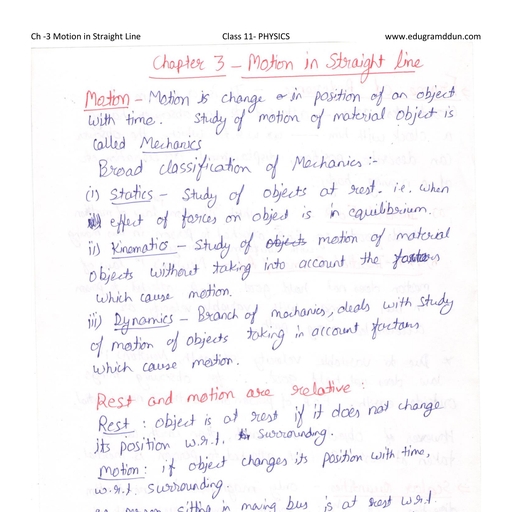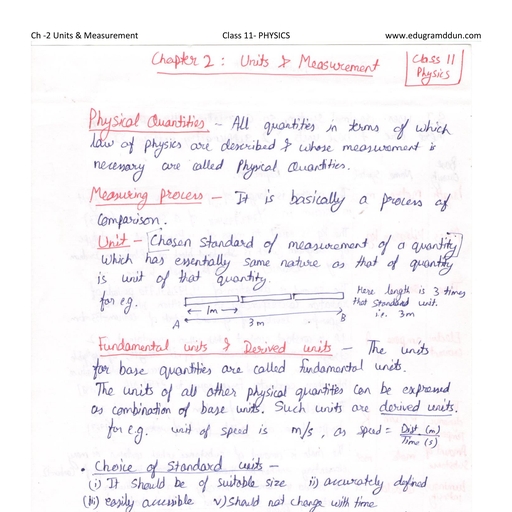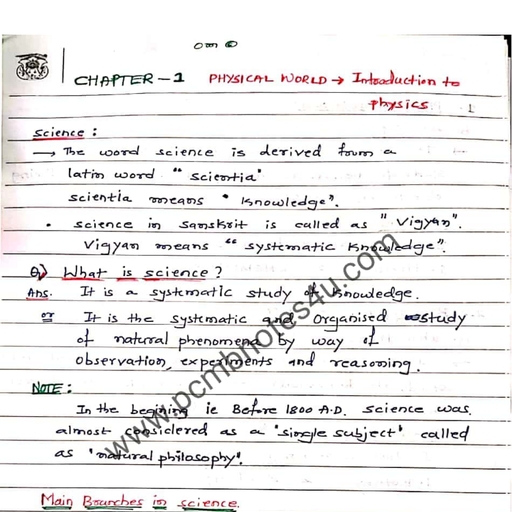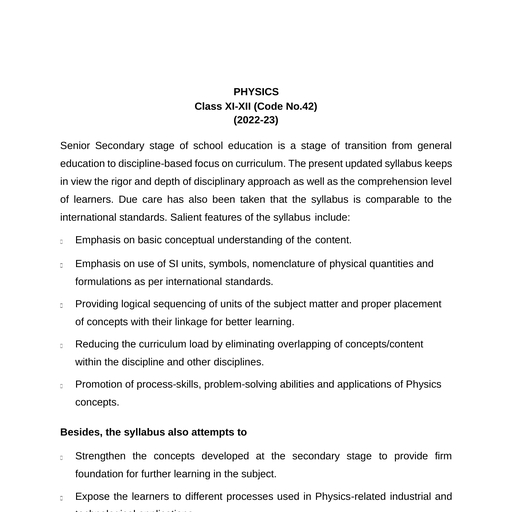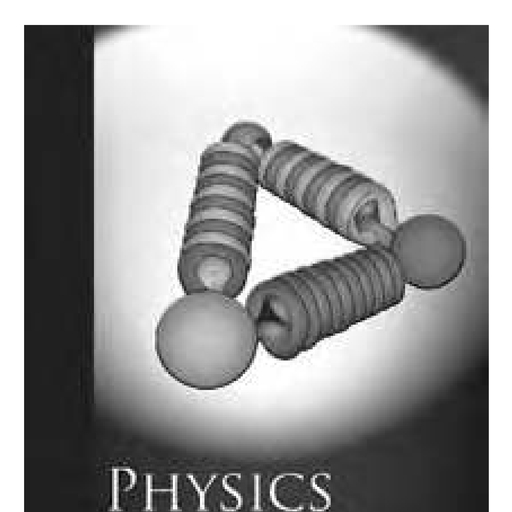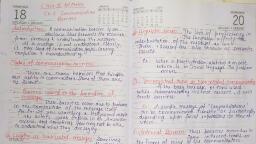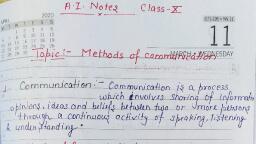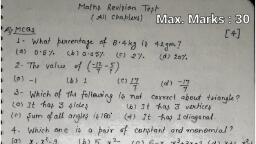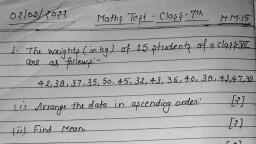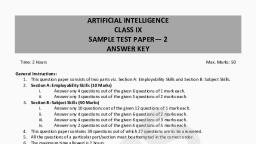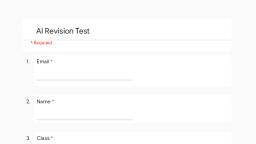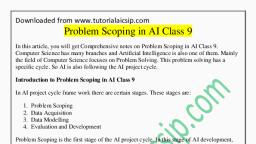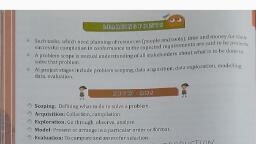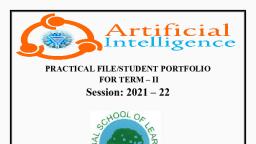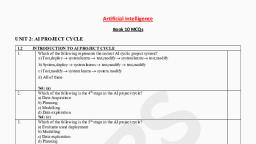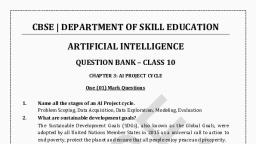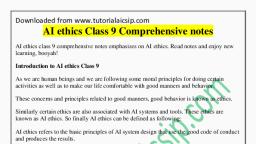Page 1 :
Downloaded from www.tutorialaicsip.com, , Problem Scoping in AI Class 9, In this article, you will get Comprehensive notes on Problem Scoping in AI Class 9., Computer Science has many branches and Artificial Intelligence is also one of them. Mainly, the field of Computer Science focuses on Problem Solving. This problem solving has a, specific cycle. So AI is also following the AI project cycle., Introduction to Problem Scoping in AI Class 9, In AI project cycle frame work there are certain stages. These stages are:, 1., 2., 3., 4., , Problem Scoping, Data Acquisition, Data Modelling, Evaluation and Development, , Problem Scoping is the first stage of the AI project cycle. In this stage of AI development,, problems will be identified. It is then followed by designing, developing, or building, and, finally testing the project., In AI project cycle everything will be failed if problem scoping is failed or without, appropriate problem scoping. Incorrect problem scoping also leads to failure of the project as, well., What is Problem Scoping?, Whenever we are starting any work, certain problems always associated with the work or, process. Actually we are surrounded by problems! These problems can be small or big,, sometimes we ignore them, sometimes we need an urgent solution otherwise your work will, suffer., The problem scoping refers to the identification of a problem and the vision to solve it., In the next section we will discuss the 4Ws of problem scoping in ai class 9., The 4Ws of Problem Scoping, The 4Ws are very helpful in problem scoping. They are:, 1. Who? - Refers that who is facing a problem and who are the stakeholders of the, problem, 2. What? - Refers to what is the problem and how you know about the problem, 3. Where? - It is related to the context or situation or location of the problem, 4. Why? - Refers to why we need to solve the problem and what are the benefits to the, stakeholders after solving the problem, 1|Page
Page 2 :
Downloaded from www.tutorialaicsip.com, The final outcome of problem scoping in ai class 9 is the problem statement template., The problem statement template, When the above 4Ws are completely filled you need to prepare a summary of these 4Ws., This summary is known as the problem statement template. This template explains all the, key points in a single template. So if the same problem arises in the future this statement, helps to resolve it easily., Recommended: Unit 1 Introduction to AI, In the next section of problem scoping in ai class 9, we are going to discuss an activity given, in the syllabus., Activity - Brainstorm around the theme and set a goal for the AI project, In this activity you need to select a theme for problem scoping., Select the Theme, In CBSE Study Material they have given the following themes for problem scoping:, , Students can select any of these or they can choose their own as well., Now answer the following questions:, Why you have selected the theme?, For Example,, 1. The environment is your theme. So think about the various problems such as polluted, air, water, and land, etc., 2. Suppose you have selected an Agriculture theme, then there are various pesticides, used in agriculture to increase the productions, sowing and harvesting problems, etc., 2|Page
Page 3 :
Downloaded from www.tutorialaicsip.com, 3. Traffic is also one of the themes given in the handbook. Here you can think about, traffic issues and to reduce the accidents or any other related problem., Similarly you can take any theme and think about the various problems of that theme., Place the problems into a problem statement template, As per the handbook they have given a sun and fill the rays with the problems found in your, theme., Now list down the problems and topic for your theme., Set up the goal, After understanding and writing the problems, set your goals, and make them your AI, project target. Write your goals for your selected theme., Suppose you have selected theme of agriculture then write how AI will help farmers to solve, their problems., 1. Determine what will a good time for seeding?, 2. Determine what will be a good time for harvesting?, 3. Determine when and how much fertilizer will be applied to the selected crop?, These goals can be more!, Now think and apply the 4Ws strategy for each problem or goal. Your final problem, statement will look likes the following table:, Who, , Stakeholders, Farmers, Fertilizer Producers, Labours, Tractor Companies, , What, , The problem, Issue, Need, Determine what will a good time for seeding or crop harvesting?, , When, , Context/Situation, Decide the mature age for the crop and determine its time, , Ideal Solution, , Benefits, Take the crop on time and supply against market demand on time, , Suggested: Unit 2 AI Project Cycle, 3|Page
Page 5 :
Downloaded from www.tutorialaicsip.com, , Data Acquisition AI Class 9, If you are looking for the comprehensive notes for Data Acquisition AI Class 9, then you, reached on the perfect article for the same., In this article, we will discuss sub unit Data Acquisition AI Class 9 that is part of Unit 2 AI, project cycle of Class 9 CBSE curriculum., Before starting this article, I would like to recommend you to go through the previous article, by following the link:, Problem Scoping, Introduction to Data Acquisition AI Class 9, Data Acquisition consists of two words:, 1. Data : Data refers to the raw facts , figures, or piece of facts, or statistics collected for, reference or analysis., 2. Acquisition: Acquisition refers to acquiring data for the project., The stage of acquiring data from the relevant sources is known as data acquisition., Now you need to understand the classification of data for Data Acquisition AI Class 9., Classification of Data, Now Observe the following diagram to for the data classification, we will discuss each of, them in detail:, Basic Data, Basically, data is classified into two categories:, 1. Numeric Data: Mainly used for computation., Numeric data can be classified into the following:, o Discrete Data: Discrete data only contains the, integer numeric data. It doesn't have any decimal, or fractional value. The countable data can be, considered as discrete data. For example 132, customers, 126 Students etc., o Continuous Data: It represents data with any, range. The uncountable data can be represented in, this category. For example 10.5 KGS, 100.50 Kms, etc., 1|Page
Page 6 :
Downloaded from www.tutorialaicsip.com, 2. Text Data: mainly used to represent names, collection of words together, phrases,, textual information etc., Structural Classification, The data which is going to be feed in the system to train the model or already fed in the, system can have a specific set of constraints or rules or unique pattern can be considered as, structural data., The structure classification is divided into 3 categories:, 1. Structured Data: As we discussed the structured data can have a specific pattern or, set of rules. These data have a simple structure and stores the data in specific forms, such as tabular form. Example, The cricket scoreboard, Your school time table, Exam, datasheet etc., 2. Unstructured Data: The data structure which doesn't have any specific pattern or, constraints as well as can be stored in any form is known as unstructured data. Mostly, the data that exists in the world is unstructured data. Example, Youtube Videos,, Facebook Photos, Dashboard data of any reporting tool etc., 3. Semi-Structured Data: It is the combination of both structured and unstructured data., Some data can have a structure like a database whereas some data can have markers, and tags to identify the structure of data., Other Classification, This classification is sub divided into the following branches:, 1. Time-Stamped Data: This structure helps the system to predict the next best action. It, is following a specific time-order to define the sequence. This time can be the time of, data captured or processed or collected., 2. Machine Data: The result or output of a specific program, system or technology, considered as machine data. It consists of data related to a user's interaction with the, system like the user's logged-in session data, specific search records, user engagement, such as comments, likes and shares etc., 3. Spatiotemporal Data: The data which contains information related to geographical, location and time is considered as spatiotemporal data. It records the location through, GPS and time-stamped data where the event is captured or data is collected., 4. Open Data: It is freely available data for everyone. Anyone can reuse this kind of, data., 5. Real-time Data: The data which is available with the event is considered as real-time, data., 6. Big Data: You may hear this word most often. The data which cannot be stored by, any system or traditional data collection software like DBMS or RDBMS software can, be considered as Big data. Big data itself a very deep topic., 2|Page
Page 7 :
Downloaded from www.tutorialaicsip.com, Data Features, Data features refer to the type of data you want to collects. Here two terms are associated, with this:, 1. Training Data: The collected data through the system is known as training data. In, other words the input given by the user in the system can be considered as training, data., 2. Testing Data: The result data set or processed data is known as testing data. In other, words, the output of the data is known as testing data., The big data and some of the characteristics of big data is explained in this article., Recommended, Unit 1, Unit 2, , 3|Page
Page 8 :
What is Data Exploration?, , Data Exploration, , Data Exploration refers to the techniques and tools used to visualize data through complex, statistical methods., Advantages of Data Visualization, A better understanding of data, Provides insights into data, Allows user interaction, Provide real-time analysis, Help to make decisions, Reduces complexity of data, Provides the relationships and patterns contained within data, Define a strategy for your data model, Provides an effective way of communication among users, Data Visualization Tools, There are many data visualization tools available. Here I made a list of 20 data visualization, tools for you. Although there are many more tools available and these numbers increasing day, by day., 1. Microsoft Excel, 2. Tableau, 3. Qlikview, 4. FusionCharts, 5. DataWrapper, 6. MS Power BI, 7. Google Data Studio, 8. Sisense, 9. HiCharts, 10.Xplenty, , 11.HubSpot, 12.Whatagraph, 13.Adaptive Discovery, 14.Teammate Analytics, 15.Jupyter, 16.Dundas BI, 17.Infogram, 18.Google Charts, 19.Visme, 20.Domo, , How to select a proper graph for data visualization, Now you are familiar with various chart types. Now the next step is to select an appropriate, chart for data visualization. The selection of chart all depends on the data and the goal you are, going to achieve through your model. Although some basic purposes of charts that let you select, an appropriate chart, they are as follows:, 1. Comparison of Values – Show periodical changes i.e. Bar Chart, 2. Comparison of Trends – Show changes over a period of time i.e. Line Chart, 3. Distribution of Data according to categories – Show data according to category i.e., Histogram, 4. Highlight a portion of a whole – Highlight data according to value i.e. Pie Chart, 5. Show the relationship between data – Multiple charts can be used
Page 9 :
Fundamental of charts in Excel, Charts are graphical or pictorial representation of data., Advantages of creating charts in excel, Charts offer the following advantages:, Provides visualization, Proper understanding, The flow of data explanation, Makes your data more attractive and presentable, Increases User’s engagement, Help see the relationship between data, Types of charts in Excel | Excel Graph, Excel offers several types of charts. These types of charts you will see when you click on the, Insert tab in MS-Excel from the charts group. Observe in the following screen:, , Creating charts in Excel, This chart group provides the following chart types, as marked by the group with numbers., 1. 2D – 3D Column Chart, 2. 2D – 3D Line Chart, 3. 2D – 3D Pie and Doughnut Chart, 4. 2D – 3D Bar Chart, 5. 2D – 3D Area Chart, 6. Scatter and Bubble Chart, 7. Stock, Surface and Radar Chart, 8. Combo Chart, 9. Pivot Chart, 1. Column Chart, The column chart is generally used to compare the data. It shows periodically changes in the, data. In a cricket match, you might have seen this chart which displays the bowler’s bowling, spell analysis or team score at 10 overs interval. As you are aware that there will be two axes in, the chart x-axis and y-axis. Now observe the following data:, , 2D column chart in excel, 3D columns in MS Excel, Observe both column charts and understand the difference between them.
Page 10 :
2. Line Chart, Line charts are usually used to compare trends in data at equal intervals. It shows the changes, over a period of time. It is useful for plotting the values when you have different trend values., In cricket matches, you might have seen these charts with a comparison of two team scores., Observe this data now:, , data for line chart, So in the above data Score of each house is inserted for Term I and Term II. Now just I am, creating 2D line chart in Excel for the same and displayed in the following screenshot., , 3D line chart in MS Excel, , 2D Line Chart in Excel, Now observe the 3D line chart in Excel with the same data., , 3. Bar Chart, Bar chart is reverse form of column chart. As in column chart categories are organized, horizontally and values vertically, in bar chart categories are organized vertically and values, horizontally. Observe the following screenshot:, , 2D Bar Chart in Excel, The 3D bar chart is displayed in the, following screenshot., , 3d Bar Chart in Excel
Page 11 :
4. Scatter Chart, A Scatter chart is a little bit similar to the line chart that displays only dots plotted on the plot, area. Observe the following screenshot., , Scatter chart in MS Excel, 5. Pie Chart, It is used to plot the values for a single data series. You can display the graphics for the entire, year’s performance in slices., , Data for pie chart, , Pie chart in Excel, , Now observe the following screenshot:, 6. Doughnut Chart, It is used to shows the relationships between different parts and makes one circle. It contains, more than one data series. It shows one circle for each and one data series., , Doughnut Chart in Excel, , 3D Area Chart in Excel, , 7. Area Chart, It is a filled colored version of a line chart. It fills a color between two lines. It highlights the, size of the change in data over time.
Page 12 :
8. Radar Chart, In this chart, data will be plotted in concentric circles. Each data series is plotted along a, separate axis from the center point to the outer ring. The line connects values from the series., , Radar Chart, Creating a chart in Excel | Creating a graph in Excel, Creating a chart in excel is quite simple and easy. Follow the following steps to create a chart in, excel., Step 1: Prepare your data., Step 2: Select the data which you want to plot on the chart., Step 3: Click on insert → select desired chart type., Components of chart | Chart Elements, If you want to see all the chart elements then follow the following steps after creating the chart:, Step 1: Click on the chart., Step 2: A + symbol will appear to the right, side of your chart as displayed in the following, screenshot., Step 3: Click on the circled + button it will display drop-down with all chart elements as, displayed in the following screenshot., Step 4: Click on respective chart element to show/hide on the chart., , Chart Element Button, , Chart elements dropdown
Page 13 :
Downloaded from www.tutorialaicsip.com, , Comprehensive notes on AI project Cycle modelling class 9, Students, in this article we will talk about AI project cycle modelling class 9. We have, already seen the ways of data exploration, the next stage for AI project cycle is modelling, which we call AI project cycle modelling class 9., AI project Cycle modelling class 9, Before starting AI project Cycle modelling class 9, you need to understand what is, modelling? So it can be defined as follows:, AI Modelling refers to developing algorithms, also called models which can be trained to get, intelligent outputs. That is writing codes to make a machine artificially intelligent., So as in previous article data exploration, we have seen how we can represent data in, graphics using various tools. This graphical representation makes data easy to understand for, the humans to take a decision or prediction. But when it comes to machine to access and, analyse data, machine requires mathematical representation of data. Hence every model, needs a mathematical approach to analyse data., In the next section of AI project Cycle modelling class 9 we will talk about AI modelling, approaches., AI modelling approaches, Basically there are two approaches broadly taken by researchers for AI modelling. They are:, 1. Rule-Based Approach, 2. Learning-Based Approach, 3. Decision Tree, Let us begin with rule based approach for AI project Cycle modelling class 9., , 1|Page
Page 14 :
Downloaded from www.tutorialaicsip.com, Rule Based, A Rule-based approach is generally based on the data and rules fed to the machine, where, the machine reacts accordingly to deliver the desired output., In other words, rule-based learning follows the relationship or patterns in data defined by the, developer. The machine follows the instructions or rules mentioned by the developer and, performs the tasks accordingly. It uses coding to make a successful model., Consider the following scenarios and try to understand the rule-based approach for AI, project Cycle modelling class 9:, Suppose you have data of 100 employees and 100 businessmen. The following steps you, need to follow to train your machine:, 1. Input your data and label them accordingly for employees and businessman., 2. Now if the data is related to employee, the machine will compare its rules defined by, you as employee and label it as employee and this way it will identify the data of, employee., 3. Similarly it will follow the rules for businessman as well., Here in the machine, you need to feed some of the characteristics of employees like earning, money and provide service whereas businessman investing money and provide service to, train the machine., In CBSE curriculum handbook they have following example for rule-based approach., Suppose you have a dataset comprising of 100 images of apples and 100 images of bananas., To train your machine, you feed this data into the machine and label each image as either, apple or banana. Now if you test the machine with the image of an apple, it will compare the, image with the trained data and according to the labels of trained images, it will identify the, test image as an apple. This is known as Rule-based approach. The rules given to the, machine in this example are the labels given to the machine for each image in the training, dataset., 2|Page
Page 15 :
Downloaded from www.tutorialaicsip.com, Observe the following image:, , The second approach in AI project Cycle modelling class 9 is learning based discussed in the, next section., Learning Based, The machine is fed with data and the desired output to which the machine designs its own, algorithm (or set of rules) to match the data to the desired output fed into the machine to, train., In the learning-based approach, the relationship or pattern in data is not defined by the, developer. This approach takes random data which is fed into the machine and it is left to the, machine to figure out the patterns or required trends., In general this approach is useful when the data is not labelled and random for a human to, use them., , 3|Page
Page 16 :
Downloaded from www.tutorialaicsip.com, Thus, the machine looks at the data, tries to extract similar features out of it and clusters the, same datasets together. In the end as output, the machine tells us about the trends which are, observed in the training data., This approach is used to train the data which is unpredictable or the users have no idea about, it. Let us take a look at the example given in your curriculum handbook for AI project Cycle, modelling class 9., For example, suppose you have a dataset of 1000 images of random stray dogs of your area., Now you do not have any clue as to what trend is being followed in this dataset as you don’t, know their breed, or colour or any other feature. Thus, you would put this into a learning, approach based AI machine and the machine would come up with various patterns it has, observed in the features of these 1000 images. It might cluster the data on the basis of colour,, size, fur style, etc. It might also come up with some very unusual clustering algorithm which, you might not have even thought of!, , 4|Page
Page 17 :
Downloaded from www.tutorialaicsip.com, In the next section of AI project Cycle modelling class 9 we will discuss about decision tree., Decision Tree, The decision tree is one of the most common and basic models in data science. It follows a, tree like structure of the decisions with all possible results. It is similar like rule-based, approach., The decision tree is made up of various node. It follows top to bottom approach. The top, most node of the decision tree is known as root. Then it continues till the down to the, terminal node or leaf node. All these nodes are connected with each other by arrow lines. So, let us talk about the common terms associated with decision tree., Now we will talk about common terms of decision tree for AI project Cycle modelling class, 9., Common Terms, 1. Root Node: We have already seen this in the above paragraph., 2. Splitting: Splitting is a process by which a node is divided into two or more subnodes., 3. Decision or interior node: It is the node where the splitting takes place. In other, words, it is a place where the sub-node is divided into another sub-nodes., 4. Leaf node or terminal node: We have already seen this., 5. Branch or Subtree: A subsection of the decision tree is known as a branch or subtree., 6. Parent node and child node: The bottom node which derives from the top node is, known as child node whereas the top node is known as the parent node., Different Parts of Decision Tree, The decision tree is made up of various nodes. These nodes are the parts of a decision tree., They are as follows:, 1. Decision Nodes: It represents a decision , typically shown with square, 2. Chance Nodes: It represents probability or uncertainty, shown in circle, 3. End Nodes: It represents the result or final outcome, shown in triangle, In next section we will see the practical part how to prepare a decision tree. Till then keep, reading and enjoy learning., Go through the following links:, Unit 1 Introduction to Artificial Intelligence, Unit 2 AI Project Cycle, , 5|Page
Page 18 :
Possible Ethical Concerns:, 1. The AI system will monitor the residents of the colony/village round the clock. This has, ethical concerns related to privacy., 2. The AI system will store the data related to the residents of the colony, including the, entry/exit timings, the people who accompany them, the dress they wear (if smart video is, used) etc. The ethical use of this data can be a concern, 3. The data related to the residents cannot be collected and used by the AI system without, their approval or permission. This can lead to unethical collection and use of data., , Chapter 2, Worksheet 1, 1. Write the name of the five stages of the AI Project Cycle., 2. Add the sub-stages of Problem Scoping, Data Acquisition, Data Exploration, Modelling and, Evaluation Deployment to the five stages., 3. Add the different components of the sub-stages., , Design, , • Problem Scoping, • Business or Project, Requiements, • Analytics Approach to Products, • Data Acquisition, • Data Requirment, • Data Collection, , Develop, , • Data Exploration, • Exploratory Data Analytics, • Data Preparation, • Data Modelling, • Model Selection, , Testing, , • Evaluation, • Project Evaluation, • System Tuning, , Deploy, , • Deployment, • Project, Deployent, • Project Review, , Worksheet 2, Explain how problem scoping is beneficial for an AI project?, Problem scoping is part of the project planning stage. This stage allows for establishing project goals, i.e. what has to be achieved? Identifying different stakeholders, the existing measures for solving the, problem and the ethical concerns related to the project., Worksheet 3, Two examples of Structured Data, , © Kips Learning Pvt. Ltd. 2020
Page 19 :
1. Class Attendance Register, 2. Student Mark Sheets, Two examples of Unstructured Data, 1. Medial Records of the patients, 2. Social Media data of users, Two examples of Big Data, 1. All the data related to students with the school (including exam and test answer sheets), 2. All the data on the mobile phone., Worksheet 4, Sr. Name, , Developer, , 1, , Power Bi, , Microsoft, , 2, , Tableau, , Tableau Software, , 3, , Excel, , Microsoft, , 4, , Data Studio Google, , 5, , Qlik Sense, , QlikTech International, , Worksheet 5, Identify and name the different sections of the following Decision Tree, , Worksheet 6, 1. How can Project evaluation help in boosting research area?, © Kips Learning Pvt. Ltd. 2020
Page 20 :
Project evaluation helps in finding out the answers to three important questions. First, what, went right, second what went wrong and third what was challenging. The answers to these, questions help in boosting the different research areas. What went right has to be, duplicated, what went wrong has to be corrected and what was challenging has to be, simplified. This will in turn boost the research., 2. How can Project evaluation help in gathering knowledge for accumulation?, Project evaluation deals with collection of information and its evaluation. This helps in, identifying the correct knowledge for accumulation in different forms. For example, the, successes can be retained for replication and failures can be accumulated for avoidance., 3. Name some companies that use neural networks and mention how they use it, 1. Facebook: The neural network is used for facial recognition., 2. Instagram: The neural network and deep learning is used for identifying the contextual, context of the emoji, 3. Amazon: The neural network is used for brining recommendations to the customers, 4. Google Translate: The neural network is used for automating translations, AI Quiz, QUIZ 3: Activity, Identify the Sustainable Development Goals associated with each of the following themes:, Environment: SDG 3 (Good Health and Well-Being), SDG 6 (Clean Water and Sanitation), SDG, 7 (Affordable and Clean Energy), SDG 11 (Sustainable Cities and Communities), SDG 12, (Responsible Consumption and Production), SDG 13 (Climate Action), SDG 14 (Life Below, Water), SDG 15 (Life on Land), Economy: SDG 1 (No Poverty), SDG 2 (Zero Hunger), SDG 7 (Affordable and Clean Energy),, SDG 8 (Decent Work and Economic Growth), SDG 9 (Industrial Innovation and, Infrastructure), SDG 12 (Responsible Consumption and production),, Equality: SDG 1 (No Poverty), SDG 4 (Quality Education), SDG 5 (Gender Equality), SDG 10, (Reduced Inequalities, Quiz 4: Identify and Write, You are designing an AI-based smart security system for your school. Identify the stakeholders for, this project., •, •, •, •, •, , Senior Management, Teachers, Students, Parents of students, Support Workers, , AI Ready, ACTIVITY 1: Writing Subjective Responses, Q1. How is an AI project cycle different from a normal IT project cycle?, , © Kips Learning Pvt. Ltd. 2020
Page 21 :
Normally, IT project cycle ends with the deployment phase. Any change after the deployment phase, is treated as a separate project. The AI Projects on the other hand are cyclic in nature i.e. they do not, end with the deployment phase. After deploying the system learns, then testing and deployment is, again repeated., Q2. Can we do goal setting before scoping the problem? Justify., Goal setting is one of the stages of the problem scoping. The goals of the project are established, after the identification of the problem. These goals set the boundary of the project i.e. what is and, what is not going to be done., Q3. Can we design AI systems without Data Visualisation? Why?, Strictly speaking data visualisation is not required for designing the AI systems. Data visualisation, assist in understanding of data and in recognising patterns in it. AI cannot understand data. It can, identify patterns, and human beings have to make sense of these patterns. The use of the data, visualisation will depend on the type of data system which is being designed., Q4. Are the neural networks the best rule-based systems? Why?, Artificial Intelligence systems can either be rules-based systems or they can be learning based, systems. In rules-based systems the selections or processing of data is based on user defined rules., In neural networks, the selections or processing is based on the learning done by these networks., Q5. How is reinforced learning different from supervised learning?, In supervised learning, the AI systems are provided with the problems and the correct solution. The, AI system will establish patterns in the system and use them for finding solutions after training. In, reinforced learning, AI systems do not receive the correct solutions. Rather the right action or, decision is provided with positive reinforcement (positive weight) and incorrect action or decision is, rewarded with negative reinforcement (negative weight)., Q6. Write a short note on learning-based systems., Learning based AI systems are not dependent on user established rules for processing data. These, systems rather learn by themselves. They are also known as adaptive intelligence. This learning can, take be supervised, unsupervised or reinforced learning., Q7. How does the complexity of data influence data visualisation?, Data Visualisation is dependent on the number of variables or parameters involved. Less complex, data is easier to visualise. Complex data will have to be simplified for making meaningful data, visualisation. This can be done through different techniques data segregation and classification., Q8. Write a short note on Big Data., Big data is the term used for referring to huge amount of data which cannot be stored or managed in, traditional database management systems. The Big data is continuously generated in real life. It can, be both structured/unstructured or semi-structured. It can come from various sources. This data is, very important because machine learning systems depend on it., Q9. How are sustainable development goals linked with artificial intelligence?, Artificial Intelligence can provide significant help in achieving the Sustainable Development Goals of, the United Nations. AI systems among other things can assist in, managing disasters (SDG 9),, © Kips Learning Pvt. Ltd. 2020
Page 22 :
creating and maintaining sustainable habitats (SDG 11), assisting the differently abled (SDG 10),, improving productivity (SDG 9), providing better access to education (SDG 4) etc., Q10. Differentiate between Data Acquisition and Data Exploring., Data Acquisition deals with collecting or obtaining data from different sources. This is based on the, need on the project. For example, traffic data for traffic lights management system. Data Exploration, deals on the other hand deals with finding patterns/trends from the acquired data. The AI system, will use these findings for solving the given problems., , ACTIVITY 2: Project Writing, You have been asked to develop a Smart Student Grading System for your school. For developing, this system:, 1. Set goals, 1. Calculating correct grades for student tests/papers, 2. Storing student grades for a minimum of 10 years, 3. Communicating the student grades to teachers, students, parents, school administration, etc., 4. Protection against unauthorised tempering and access, 2. Identify the stakeholders, 1. Teachers, 2. Students, 3. Parents of students, 4. School Administration, 3. Identify the existing measures, 1. Storing of student grades in database, 2. Using emails and SMS for communicating student grades to parents, 4. Identify the ethical concerns, 1. Privacy of the students might be affected, 5. Identify the data needs, 1. Previous test papers, answer sheets and the provided grading, 2. List of students along with relevant details, 6. Identify the sources of data, 1. School records, 7. Visualise mock data, Students will have to create mock data and visualise it in any of the data visualisation, software, ACTIVITY 3: Project Writing, Download data from any of the sources listed in Section 1.2 Data Acquisition. Use the data, visualisation tools for drawing insights from this data. Share the insight with the others in the class., Explanation: This is for students to try on their own. Responses may vary., , © Kips Learning Pvt. Ltd. 2020
Page 28 :
Important Q/Ans Related to AI Project Cycle, PROBLEM SCOPING, Objective Type Questions (OTQs), , 1. The __________ stage begins with the identification of the problem in the, AI project cycle. (Ans. Problem Scoping), 2. Problem scoping helps in, 1. setting the goal, 2. identifying the problem, 3. a deeper understanding of the problem, 4. All of these, 3. Which of the following W of 4Ws canvas problem helps in analyzing the, affected people directly or indirectly?, 1. who, 2. what, 3. where, 4. why, 4. The ________ are people who face the problem and would be benefited, from the solution. (Ans. Stakeholders), 5. The w for _________ among 4Ws, determine the nature of the problem., (Ans. what), 6. The w for what in 4Ws also gather the evidence to prove that the problem, you have selected actually exists. (True/False), 7. Which of the following refers to where among 4Ws canvas?, 1. stakeholders, 2. nature of the problem, 3. context/situation/location, 4. solution or benefits to the stakeholders, 8. The __________ helps to summarize all the key points into one single, template. (Ans. problem statement template), 9. If there are errors in the problem scoping, it leads to failure of the project, or delay in the project. (True/False), 10. In problem scoping, one should always consider the positive and negative, aspects of the problem. (True/False), , 4., 5., 6., 7., 8., 9., , 10., , 11., , 12., , Data Acquisition, , Objective type questions (OTQs), , This section consists of MCQs, fill in the blanks and True/False. So here we go!, 1. The ___________ is second stage of AI project cycle. (Ans. Data, Acquisition), 2. Data acquisition refers to collect data through various activities., (True/False), 3. Which of the can be a piece of information or facts and statistics collected, together for reference or analysis?, , 13., 14., 15., 16., , 1. Data, 2. Problem statement, 3. Feedback, 4. All of these, To predict the output you must train the data for the AI project., (True/False), In data acquisition the data which is provided as input is called, __________. (Ans. Training Data), The prediction data is known as _________ data in Data Acquisition., (Ans. Testing), We can provide any data for the prediction to get a better result., (True/False), The type of data being collected in data acquisition is known as, ____________. (Ans. Data Features), Which of the following is not a method to collect data?, 1. Surveys, 2. Web Scrapping, 3. Sensors, 4. Archives, Which of the following is one of the government open source for, collecting data?, 1. www.ayushmanbharat.org, 2. www.india.gov.in, 3. www.bharatdata.in, 4. www.india.com, The data which contain whole numbers categorized into which of the, following categories?, 1. Continuous numeric data, 2. non-continuous numeric data, 3. Discrete numeric data, 4. uncountable numeric data, The data which can be in the form of any value within a range is, considered as which of the following categories of data?, 1. Continuous numeric data, 2. non-continuous numeric data, 3. Discrete numeric data, 4. uncountable numeric data, Data has been organized according to some predefined rules, ideas or, unorganized. (True/False), The data which has predefined structure and organized in predefined, manner is called _________________ data. (Ans. structured), The types of data that do not have any predefined structure are known as, unstructured data. (Ans. unstructured), The combination of structured and unstructured data is known as, _________ data. (Ans. semi-structured)
Page 29 :
17. The data which is time order defining the sequence according to some, event time is known as ___________ data. (Ans. time-stamped), 18. Which of the following data helps in forming an accurate of actions over, time?, 1. structured data, 2. unstructured data, 3. semi-structured, 4. time-stamped, 19. Machine data refers to the data collected from systems or programs like, called details, emails data etc. (True/False), 20. The data from user behaviour, activities or actions is known as _________, data. (Ans. machine), 21. The data which contains both location and time information is known, __________ data. (Ans. spatiotemporal), 22. The data which is available freely for everyone to use which is not, restricted through copyrights, patents, control etc is known as ______ data., (Ans. open), 23. The data which is available as soon as an event takes place is known as, __________ data. (Ans. real-time), 24. Which of the following not one of the Vs of big data?, 1. volume, 2. velocity, 3. variety, 4. version, 25. The _____________ refers to is more concerned with maintaining and, managing the metadata rather than the database itself. (Ans. data curation), , 6., 7., 8., 9., , 10., , 11., 12., , 13., , Data Exploration, , Objective type questions (OTQs), , 1. ___________ refers to the techniques and tools that are used for, identifying important patterns and trends using graphs. (Ans. Data, Exploration), 2. Data exploration can be done using __________. (Ans. Data, Visualization), 3. You can also adopt some sophisticated statistical methods for data, exploration. (True/False), 4. For a better understanding of data exploration which of the following need, to be understood?, 1. Data Analysis, 2. Data Weak AI systems, 3. Collection of Data, 4. Data Curation, 5. Which of the following AI weak systems are used in systems for making, decisions by using user-defined rules?, 1. Brute-force, , 14., 15., , 2. Neural Networks, 3. Computer Vision, 4. Heuristic or Rule-based, The ___________ AI weak system uses decision trees for analysing every, possible option. (Ans. Brute Force), The heuristic AI weak system is used in chess games for analysing every, possible move to find out the best approach. (True/False), The __________ systems are designed to mimic the human brains., (Ans. Neural Networks), Neural Network is also known as, 1. Deep Learning, 2. Machine Learning, 3. Robot Learning, 4. Experiential Learning, Data visualization techniques are used to, 1. discover data, 2. real-time evaluation of big data, 3. getting new insights into data, 4. All of these, Graphs help users to better conclusions. (True/False), Which of the following Google tool can be used for data visualization?, 1. Google Site, 2. Google Meet, 3. Google Data Studio, 4. Google Maps, Which of the following is one of the data visualization tools?, 1. Tableau, 2. Tay, 3. Decision Tree, 4. Cortana, The __________ tool use CSV data for creating charst and maps., (Ans. DataWrapper), The ___________ tool uses Java Script and capable of producing 100, different types of charts. (Ans. Fusioncharts), , Modelling, , Objective Type Questions (OTQs), , 1. The ________ methods help to use data for making predictions or future, forecasts. (Ans. modelling), 2. Which of the following not an approach considered for modelling:, rule-based approach, learning-based approach, knowledge-based approach, All of these
Page 30 :
3. The ________ approach is based on rules and data fed into the machine., (Ans. rule-based), 4. In rule-based approach the relationships or patterns in data are defined by, the developer. (True/False), 5. The ___________ is used to make a successful model using rule-based, approach. (Ans. coding), 6. In _________ approach of the modelling, machine designs its own, algorithm for data. (Ans. learning-based), 7. In learning-based approach, data can be taken randomly from anywhere., (True/False), 8. The ___________ approach can be used when data is labeled. (Ans. rulebased), 9. The __________ follows tree like structure of the decisions with all, possible results. (Ans. decision tree), 10. The top most node of decision tree is known as ___________ (Ans. root), 11. Which of the following node is the last node of a decision tree?, root, terminal, interior, parent, 12. ________ is a process by which a node is divided into two or more subnodes. (Ans. Splitting)


